The marlin .45-70 was introduced in 1873 by the US Army as a substitute for the .50-70-450 round. The .45-70 is still the first choice of many seasoned hunters for short-range hunting in dense woods.
Due to low velocity, it doesn’t damage the game too much. This is the reason behind the popularity of the .45-70 cartridge. If you’re hunting big game animals, you’ll need to pair up with a good scope to work with your rifle.
We’re here to help you do just that. This guide will provide unbiased review on some of the best scopes for .45-70 that you can buy. We’ll also share a comprehensive buying guide so that finding the best optic for 45-70 rifles becomes much more convenient and straightforward.
Let’s jump right in!
Best Scope for .45-70 Reviews
1 Vortex Optics Crossfire II 1-Inch Tube Riflescopes (Top Pick)
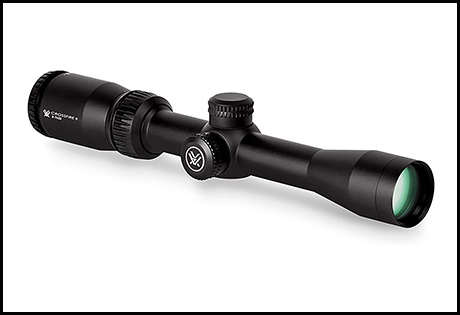
The Vortex Crossfire II is well known for its affordability and higher-quality structure. The first thing you’ll notice is that it comes with a nice and long eye relief distance.
Vortex Crossfire II is compatible with both the ring and the rail systems, and either option will work nicely; it all comes down to your personal preference. It’s basically a rimfire optic that doesn’t add a lot of weight to your rifle.
The lightweight and compact body comes handy when moving to your hunting locations. The O-ring sealing and nitrogen purging allow for proper weatherproofing. The only drawback is that it has no parallax adjuster.
But Crossfire II can maintain its accuracy up to 800 yards, so you might not miss having a parallax adjustment at all. The turrets work great if you take the time to boresight the scope with a good bore sighter.
With each turn, the turrets gave a positive click feel, and we faced no mushiness. We did face a little difficulty holding the zero in, but it was fixed with a little adjustment.
The dead-hold BDC Reticle isn’t illuminated, but the crystal clear lens makes up for it. The 40mm objective lens allows for a good amount of light transmission, causing a brighter image. The scope also has a V-Brite Illumination and if you really like illuminated ones, go for that style.
Specifications
- Magnification: 3-9x
- Objective Lens: 40mm
- Lens coating: Fully Multi-coated
- Illumination: None
- Eye Relief: 3.8inch
- Weatherproofing: Water, Fog & Shock
- Parallax adjuster: None
- Reticle: Dead-Hold BDC Reticle
- Body: Aircraft-Grade Aluminum material
- Length: 11.8inch
- Weight: 15oz
- Warranty: Lifetime
Pros
- Longer eye relief
- Light-weight
- Durable build
- 2nd focal plane reticle
- Fully weatherproof
- Nice turrets
- Affordable
- Fast focus
- Matte body finish
Cons
- Difficulty holding a zero
Our Verdict
The Crossfire II is a budget-friendly scope that suits the .45-70 best. Yes, there are expensive Vortex scopes but the Crossfire II offers excellent value for money.
This is an awesome choice for entry-level hunting actions, and due to its ease-of-use, it’s a great beginner’s choice.
This agile optics comes with superb clarity, classic set of power, adequate sight picture, and at an affordable price while Vortex’s warranty is the cherry on top.
2 UTG 3-12X44 30mm Compact Scope (Ultra-Durable Choice)
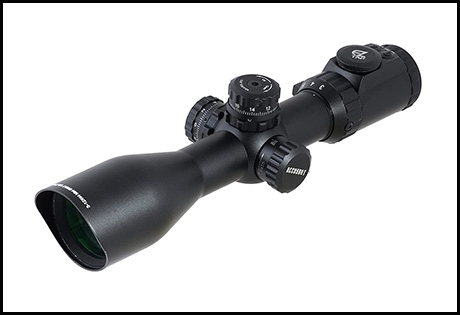
Whoa! This UTG model offers 36-colors illuminations. This scope will certainly come in handy for color blind people.
A scope is of no use if it fails to deliver and you’ll never have to worry about that with the UTG 3-12X44. Trust us; you will fall in love with this scope. With a large body and a heavy-duty build, this is built to last an eternity.
The EZ-Tap buttons feel great on the hand, but the illumination is not bright enough. In daylight, you won’t notice whether it’s turned on or off. There’s also a bit of light bleeding effect as the light spreads inside rather than just the crosshairs.
You’ll lose some eye relief above 10x, and it becomes a bit hazy. The mil-dot reticle is a bit thick but usable. The parallax adjuster focus knob on the left side is actually great and makes it easy no matter what distance you’re at.
This is the toughest scope you’ll ever own in this price range. We actually covered 1000 yards multiple times and zeroed in with no complications at all.
But we noticed going further than 10x required a bit of light. Even with illumination, it didn’t perform great in low-light situations. It comes with a battery, scope rings, and everything else necessary.
Specifications
- Magnification: 3-12x
- Objective Lens: 44mm
- Lens coating: Emerald Multi-coated
- Illumination: Yes
- Eye Relief: 3.3inch
- Weatherproofing: Water, Fog & Shock
- Parallax adjuster: Yes
- Reticle: Mil-Dot Reticle
- Body: Aircraft-Grade Aluminum material
- Length: 14 inch
- Weight: 25.6oz
- Warranty: Lifetime
Pros
- Ultra-durable build
- 2nd focal plane reticle
- Lockable adjustments
- Reticle color adjustment
- Multi-color reticle options
- Fully weatherproof
- Affordable
- Matte body finish
Cons
- Darker image
Our Verdict
Though it has good illumination, under low light conditions, we found our image to be a bit dark. This was not a serious issue though and it did well; we just expected better in low-light conditions. The glass is pretty clear, better than most in this price range, but not the greatest.
We loved how the windage and elevation adjustments were made lockable – this nice feature helps keep your aim stable. We also found the reticle color adjustment quite useful. It’s simply a great choice if you’re cash-strapped but want accuracy in your scope.
3 Nikon Buckmasters II 3-9×40 BDC (Ultra-Clarity)
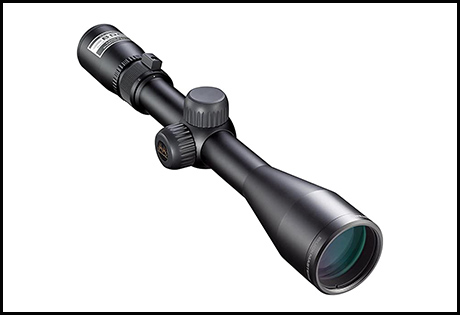
When Bushmasters and Nikon joined together to manufacture a rifle scope, you know it’s got to be amazing. Yes, Nikon Buckmasters II is amazing but its selling point is the glass. It’s the only low-light compatible crystal clear glass with the highest clarity we ever came across in such a low budget.
The fully multi-coated lenses boost light transmission, and the matte body reduces overall reflection as well. Though there’s no illumination, we didn’t have any problem in target acquisition, even under lower-light conditions.
Nikon Buckmasters II allows for great eye relief with a bright and clear image. The field of view is crucial for tracking game and it offers an amazing field of view from 11.3 feet to 33.8 feet at 100 yards that’s so handy when hunting deer.
The spring-loaded turrets have a good grip that can be pulled up to rotate them back to zero. Instead of locks, they have protective caps, which is also good.
You can zero in the scope pretty fast, and it didn’t take us long to set up the dead-hold BDC dots reticle. But there was difficulty with holding zero and the scope parallax was set at 100 yards. We would’ve worshiped it if it had an adjustable parallax.
Specifications
- Magnification: 3-9x
- Objective Lens: 40mm
- Lens coating: Fully Multi-coated
- Illumination: None
- Eye Relief: 3.6inch
- Weatherproofing: Water, Fog & Shock
- Parallax adjuster: None
- Reticle: Patented BDC Reticle
- Length: 12.3inch
- Weight: 13.1oz
- Warranty: Limited Lifetime
Pros
- Ultra-clear glass
- Fully weatherproof
- Higher light transmission – Brighter images
- Durable build
- 2nd focal plane reticle
- Affordable pricing
- Quick focus eyepiece
- Matte body finish
Cons
- Poor weatherproofing
Our Verdict
If you’ve used any Nikon camera before, you know how great their lenses are. The Nikon Buckmasters II may not have an illuminated reticle or a parallax adjuster, but it provides the highest level of clarity possible.
This might be the only thing you’re missing in your hunting gear. You can also put it on a single shot rifle. Trust us, you can bring down any beast with this rifle accessory. Overall, it’s an excellent scope for sale and we can’t recommend it more.
4 Vortex Optics Diamondback Riflescopes
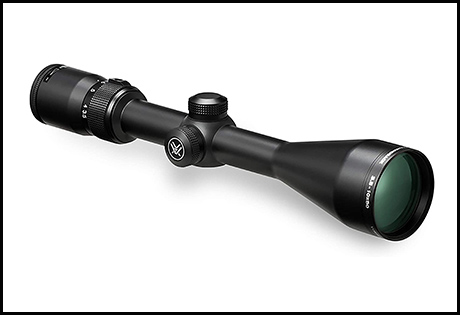
Vortex Optics is a name of trust and their Diamondback scopes live up to that expectation. It is bright, clear, and pretty accurate. The existence of metal on “metal turrets” is not so common actually. The turrets are precise and give you the ability to zero resets after sighting in.
Adjusting the sight is easy with assertive clicks as you adjust the crosshairs, with each click equaling about 1/4 MOA adjustments. Clicks are not too soft or stiff but just right. The scope is fairly light yet has a durable body.
The Vortex Optics Diamondback exceeded our expectations in many ways. The level of clarity matches with those scopes that cost twice as much. The zoom has a thumb-friendly design.
We previously tested some scopes that changed the shot when zoomed in and out, but we never faced this with the Diamondback.
This variable long-range power scope comes with a dead-hold BDC Reticle. But the 2nd focal plane doesn’t allow the reticle to enlarge when zoomed in and the reticle also does not obstruct your view.
However, it does not come with a parallax adjuster that might be a bummer for some. But you won’t have a hard time adjusting it. It once fell off of our shoulders and onto the gritty asphalt road. The device had some scratches, but was still on point.
Specifications
- Magnification: 4-12x
- Objective Lens: 40mm
- Lens coating: Fully multi-coated
- Illumination: None
- Eye Relief: 3.1inch
- Weatherproofing: Water, Fog & Shock
- Parallax adjuster: None
- Reticle: Dead-Hold BDC Reticle
- Body: Aircraft-Grade Aluminum material
- Length: 12inch
- Weight: 14.6oz
- Warranty: Lifetime
Pros
- 2nd focal plane reticle
- Metal turrets
- Rigid build
- Great in low light
- Fully weatherproof
- Fast focus
- Lightweight
- Matte body finish
- Fast optical focusing view
- Fully multi-coated lens
Cons
- Lower eye relief
Our Verdict
The Vortex Optics Diamondback is worth every penny. It’s easy to dial in, and you won’t have to struggle to adjust it. It is a bit lighter than other scopes. The rigid device will endure rough use for years. Also, the glass is crystal clear, even at full power.
Though the reticle is not illuminated, it still does well in low light conditions. It’s easy to set up, and the clicking mechanisms are satisfying. If you don’t want to go all out on a scope, and want the best budget scope for 45-70, you can’t go wrong with this purchase.
5 Vortex Optics Strike Eagle Riflescopes
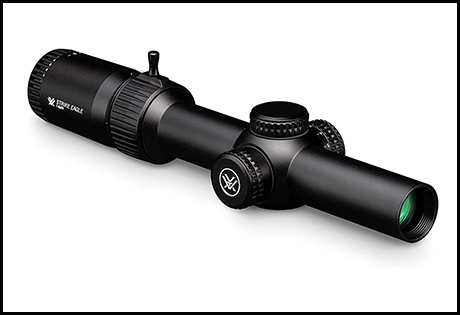
The Vortex Optics Strike Eagle is a well-built .45-70 scope from head to toe. The aluminum body is thick and solid enough to take some beating and withstand drops. It has up to 4-24x magnification to choose from. The left turret has battery storage that will surely come in handy.
The scope has an illuminated glass-etched BDC Reticle; on the right, you have an 11 dial illumination intensity adjuster. Sadly, the illumination didn’t manage to impress us even with maximum settings, we have seen brighter. Running it on the max setting will easily do the job on a sunny day.
We found the etched reticle highly visible when shooting outdoors. The little low profile bump on the zoom knob assists in changing your zoom. Windage and Elevation turrets have nice clean clicks.
The illuminated BDC reticle performs great at close range. It easily draws your eye to the circle; you’ll be able to land quick shots on target. The lower hash marks work well for different ranges. The reticle size wouldn’t change with magnification. So it won’t obstruct your view even at max magnification.
They provided quality glass for the price but that’s not good enough as Extra-Low Dispersion glasses like Vortex provides in other scopes.
Yes, the XD Glasses are awesome, but you’ll be more than satisfied with the glass this scope offers. Clarity and magnification are pretty close to true 1x magnification. You might notice a bit of a fish eye in a small room.
It comes with a pre-installed scope cover, which was a nice little touch. The fast-focus eyepiece really does perform well. The scope is parallax free up to 100 yards, which is a good thing, but it doesn’t have a parallax adjuster.
Specifications
- Style: BDC3
- Magnification: 1-8x
- Objective Lens: 24mm
- Lens coating: Fully multi-coated
- Illumination: Yes
- Eye Relief: 3.5inch
- Weatherproofing: Water, Fog & Shock
- Parallax adjuster: None
- Reticle: Glass Etched BDC Reticle
- Body: Aircraft-Grade Aluminum material
- Length: 10.5inch
- Weight: 17.6oz
- Warranty: Lifetime
Pros
- Rigid build
- Great in low light
- Fast optical focusing view
- Has a thick anti-reflective layer
- Fully multi-coated lens
- Glass etched BDC reticle great for outdoor
- Battery storage
Cons
- No parallax adjuster
Our Verdict
Vortex produces remarkable quality scopes. Our number one product is another Vortex model! If you’re looking for an awesome scope great for long-range shooting, then look no more, because this is it. We would recommend avoiding its maximum range.
It held up pretty well under every lighting condition. It easily has provided us with the needed clarity and magnification necessary for the expected shots. The Vortex Optics Strike Eagle scope offers everything a hunter could ask for; we would whole-heartedly recommend it.
6 Nikon PROSTAFF 3-9 x 40 Black Matte Riflescope

The Nikon PROSTAFF doesn’t have an outstanding design that you’ll be awed with. But it has something far greater than most of the scopes have.
With the highest level of glass clarity and light transmission of 98%, this scope creates the brightest image. For such high clarity and light transmission, this scope can even be compared to expensive models.
Nikon is a well-known brand for its advanced cameras, scopes, and binoculars. They have been one of the leading scope glass manufacturers in the world. You can quickly focus on pinning your target thanks to the sharp and bright scope image.
The matte black finish on the Type-III Aircraft-Grade Aluminum body gives a premium feel in hand. The simple classic design looks to make it less eye-catchy, but it is still a good design. It has higher durability, and the strong build makes it recoil resistant.
The scope is a bit bulky, but it fits right in. It is a big scope, so it is supposed to be a bit heavier like the PROSTAFF P3 which might be a bit bulky for guide guns, but they work anyway.
The capped turrets are sturdy; you will love the clicks while adjusting it towards accuracy. The knobs don’t feel too tight or soft while adjusting the focus.
Specifications
- Magnification: 3-8x
- Objective Lens: 40mm
- Lens coating: Fully Multi-coated
- Illumination: None
- Eye Relief: 3.6inch
- Water & fog proof
- Parallax adjuster: None
- Reticle: BDC
- Body: Type-III Aircraft-Grade Aluminum material
- Length: 12.4inch
- Weight: 28.8oz
- Warranty: Limited Lifetime
Pros
- Maximum Light Transmission 98%
- Scope caps
- Sturdy turrets
- Clear glass
- Great in low light
- Free microfiber cloth
Cons
- A bit heavy
Our Verdict
This scope has no significant cons for us to complain about. The PROSTAFF is a great bang for the buck product. With all these features, this scope is worth a lot more than it costs.
Non-mushy adjustable turrets allow fast focus, super clear class with 98% light transmission, bright scope image, and a strong build, what else can you possibly ask for in this price range.
The scope also comes with a cover, though not the best cover; it does what it’s supposed to. The scope is beginner friendly and is certainly fit for an ideal good entry-level long-range scope.
7 Monstrum 1-4×20 Rifle Scope with Rangefinder
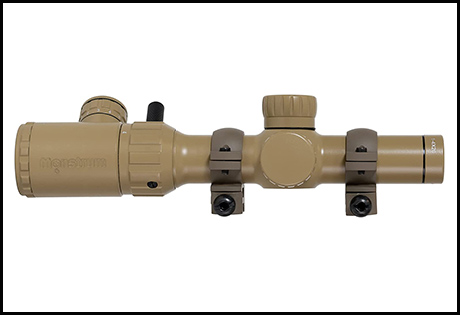
This Monstrum Tactical scope is light in weight and super compact with a length of 8.5 inch. There are a lot of things to talk about in this scope, but the first thing you might notice is the throw lever.
Throw lever-type magnification adjuster allows for rapid zooming in with maximum accuracy. The scope maxes out at 200 yards; it might not be built for long-range, but it does provide superior accuracy. Exceptionally clear glasses offer excellent clarity with optimum eye relief.
You can use the scope with both eyes open effortlessly for any magnification settings. Even with serious recoil, the scope held its zero for hundreds of rounds.
The lenses do not come fully multi-coated, but it still manages to pass through enough light-transmission making brighter sight pictures.
Some might consider it to be heavy, but depending on the build, it is not. You can’t have everything on a scope all at once. It can’t be light-weight, well built, long-range, and cheap at the same time. You just can’t have an orgy of features.
The dials, turrets, and all the adjustments feel extremely solid. It comes in two different colors-red or green illumination with five levels of brightness adjustment. No matter what sort of light condition you’re in, this scope can still nail it.
Specifications
- Magnification: 1-4x
- Objective Lens: 20mm
- Lens coating: Fully Multi-coated
- Illumination: Yes
- Eye Relief: 3.5-3.8 Inches
- Weatherproofing: Fog & Water
- Parallax adjuster: None
- Reticle: Rangefinder
- Body: 6061 Aircraft-Grade Aluminum material
- Length: 8.5inch
- Weight: 11oz
- Warranty: 1-year
Pros
- Lower price
- Robust build
- Throw level
- Rangefinder reticle
- Crystal clear glass
- Quality knobs, turrets
- Great in any light-condition
- Free Cloth and cover
Cons
- Weaker illumination turret
Our Verdict
The robust build quality is incomparable; you’re not going to do better on a 100$ budget. It offers true 1-4x power, illuminated reticle, crystal clear glass, bright image, and a rangefinder reticle. It’s almost the perfect scope.
The Monstrum brand does make good stuff for its price. If you’re searching for the best scope for a henry 45-70 rifle, this one will be a great fit for you.
8 Mueller APV 4.5-14×40 AO
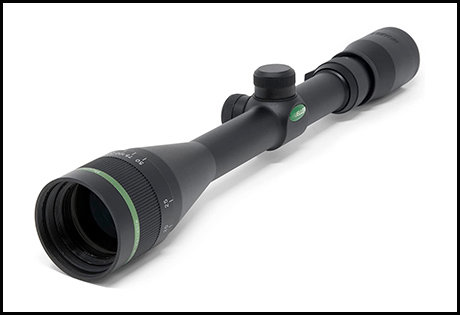
The Series name APV stands for All-Purpose Variable. And this scope is a beginner-friendly all-purpose scope. We would’ve loved it more if it had an illuminated reticle. People have an expression that if it’s made in China, it must be of lower quality. But the Mueller APV shatters this expression with a great budget-friendly scope.
The duplex crosshair has thicker crosshairs on the edge and thinner crosshairs in the aim point. Though the crosshairs are thicker, it doesn’t obstruct your view. And the 2nd focal plane keeps the reticles still when zoomed in.
The scope image is pretty clear, even at maximum zoom. Objects are clear enough without any significant blur. From any magnification, the scope image is good enough for a clean shot. The 40mm objective lens allows a good amount of light transmission.
The scope has a small viewable area. Some might have a hard time getting the hang of it. The manufacturers could have provided a better eyepiece than the stock 1.65 inch eyepiece.
The eyepiece also has locking rings that sure does help. If your rifle has a serious kick, then be a bit more careful because the scope has a smaller eye relief range.
Specifications
- Magnification: 4.5-14x
- Objective Lens: 40mm
- Lens coating: Fully multi-coated
- Illumination: None
- Eye Relief: 3.2inch
- Weatherproofing: Water, Fog & Shock
- Parallax adjustment: AO
- Reticle: Duplex Crosshair Reticle
- Length: 13.75inch
- Weight: 17.5oz
- Warranty: Limited Lifetime
Pros
- Clear glass
- Quality turrets
- Effortlessly holds zero
- AO parallax
- Affordable
- Adequate in low light
- Fully multi-coated lens
- Free sunshade
Cons
- Shorter eye relief
Our Verdict
We’ll just be brutally honest. The Mueller APV is not a perfect scope out there. But with the price they provide, you will have a hard time complaining about APV that gives such a good level of performance. Crisp, clear imaging throughout the entire magnification.
Good quality glass and the well-thought-out design allows for great light-transmission, making brighter images. The crosshair is less complicated and makes it easy for beginners.
The good qualities of this scope easily overlap the flaws. With everything in mind, you can easily come to the final decision to purchase it.
9 BARSKA Varmint Mil-Dot Riflescope
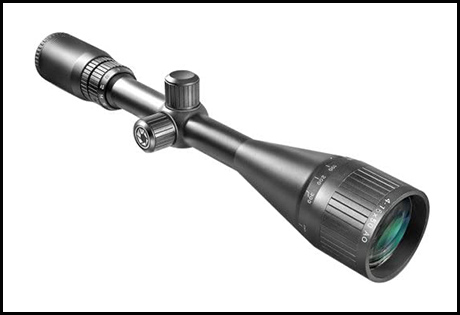
The BARSKA, as a brand, has a lot of haters for being China-made. But there are tons of good products that are made in China, for instance, Mueller. With pricing just below 80$, this is the cheapest scope model on our list. Don’t let the cheaper pricing fool you into thinking that this is one of those bad deals.
The scope is easy to mount, and you’ll be able to sight in without a hassle. Most of the lower-priced scopes face difficulty tracking properly, and often only good at a certain distance.
The magnification adjustments were nice enough to track objects properly. Turrets have protective caps and are finger adjustable for both elevation and windage; these have nice clicks to it when turned.
The turret is easily resettable to zero, but you might need a small eyeglass screwdriver. It is quite a heavy scope weighing 22oz. But it does not reduce the effectiveness of the scope. While hiking with this hanging over your shoulder, you’d probably prefer a lighter scope.
Though it is marketed as shockproof, trust us, it’s not. It is not the strongest scope on our list, so we’d recommend using it with a rifle that has a less powerful kick to it. After a few rounds, the glass turned a bit hazy; anyone can fix it right away with some maintenance knowledge.
Specifications
- Model: AC10046
- Magnification: 6-24x
- Objective Lens: 42mm
- Lens coating: Multi-coated
- Illumination: None
- Eye Relief: 3.5inch
- Weatherproofing: Water & Fog
- Parallax adjuster: AO
- Reticle: Mil-Dot Reticle
- Length: 15.7inch
- Weight: 20.46oz
- Warranty: Limited Lifetime
Pros
- Lowest price
- 2nd focal plane
- Clear glass
- Quality turrets
- AO parallax
- Adequate in low light
- Free caps & Cloth
Cons
- Foggy glass
Our Verdict
Seriously, you’d be amazed at how clear, and brighter the scope images are. When compared to Vortex Diamondback, there was no difference in the visual quality at all. Vortex Diamondback is much more expensive. Also, you’ll face no distortion whatsoever.
The BARSKA performed better than expected in low-light conditions as well. A 42mm objective lens with multi-coating gives you a clear picture.
The mil-dot reticle allows you to pin your target easily even at a long-range: a super low price, clear glass, quality turrets, and AO parallax adjustment. Put it on Henry Big Boy .45, it’ll work just fine.
You don’t just get what you pay for; you get plus ultra! So, it’s safe to say that it’s one of the best .45-70 scopes for the money. Especially if you have a marlin rifle, this can be one of the best scope for marlin 45 70, enhancing your performance significantly.
10 Primary Arms Classic Series 1-4×24 SFP Rifle Scope
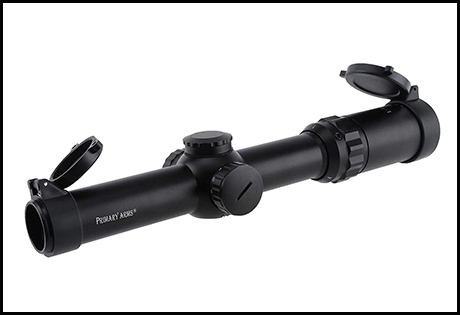
The Primary Arms brand is located in Houston, Texas. They have a good reputation for inspecting every single product to ensure top-notch quality products. The amazing thing about this scope is the eye relief. Depending on the power, it offers a nice long eye relief ranging from 3.5 to 4.9inch.
The eye relief is very pleasing but not good enough when paired with an illuminated center red-dot. The 1x setting was unable to produce a pure picture, but it was well-enough in most cases.
The glass quality of the scope is unpredictably great. We did not expect this much image clarity and brightness from a budget scope.
If you think about whether that right turret is the parallax adjuster or not. Sadly, the Primary Arms Classic does not have a parallax adjuster; the right turret is the illumination knob. The illumination knob offers 12 brightness settings.
There’s no light bleeding inside the scope when the illumination is on. While illuminating, only the dot of the duplex-dot reticle’s lights up.
Though there are so many brightness settings, we wanted a bit more illumination because the center dot illumination does not perform well enough in daylight.
Specifications
- Magnification: 1-4x
- Objective Lens: 24mm
- Lens coating: Fully Multi-coated
- Illumination: Yes
- Eye Relief: 4.9inch
- Weatherproofing: Water, Fog & Shock
- Parallax adjuster: None
- Reticle: German Duplex-Dot Reticle
- Length: 11.1inch
- Weight: 16.7oz
- Warranty: 1-year
Pros
- Long eye relief
- Great light transmission
- Premium flip-up covers
- Illumination adjuster
- Low profile turrets
- 2nd focal plane
- Clear glass
- Great in low light
- Free microfiber cloth
Cons
- Less illumination in daylight
Our Verdict
The PA14X is one of the best scopes for .45-70 with durable, fully weatherproof optics. The fully multi-coated glasses provide great clarity. While testing it, the scope held zero quite well even after firing tons of rounds.
Even though it is a low power scope, you can still cover a good distance with superb accuracy. Apart from the lesser performance of the red-dot in daylight, there’s nothing to complain about. It’s a great scope; you can buy it without any hesitation.
Best Scope for .45-70: Comprehensive Buying Guide
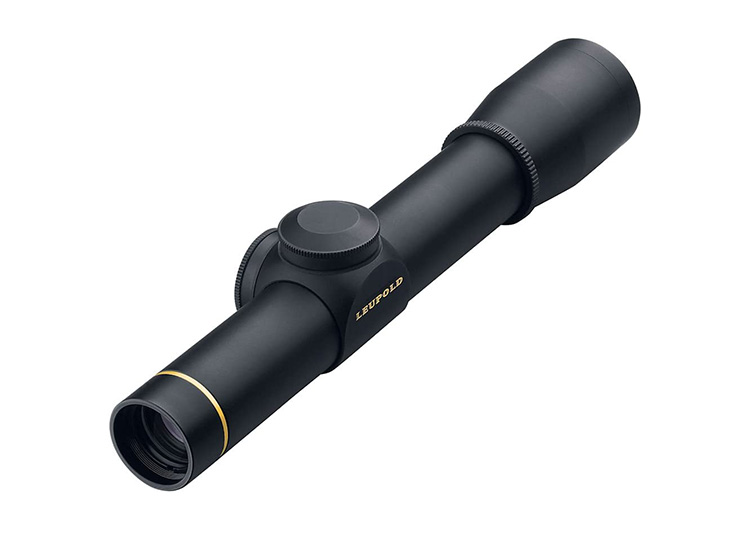
The scopes for a .45-70 Marlin or Henry H010 or any other lever action rifles don’t come cheap, which is why you should always have in-depth knowledge about scopes before you hunt for the best scope for .45-70.
Magnification
So, what is a good scope for a marlin .45-70 in terms of magnification? Well, we’ve given you the list to choose for yourself. Speaking of magnification, the term derives from magnifying, the ability to zoom in.
It determines how much closer you can see the target compared to the naked eye. It is the first thing you should look for when purchasing your scope. Based on magnification, there are two types of scope. Keep in mind that more magnification can compromise the field of view.
1. Fixed Power Scope
As the name suggests, it has one fixed magnification.
Advantages of a Fixed Power Scope:
- Offer a brighter, sharper, and clearer view to close your target
- Easier to use than a variable scope, the stock settings are just right
- It provides fewer chances of missing your target or making a mistake
- No hassle of adjusting parallax or magnification
- The body has a sturdy build
- Cheaper than variable power scope
Disadvantages of a Fixed Power Scope:
- You don’t always need a set amount of power
- Too powerful for a shorter distance
- You’ll face difficulty in pinning a closer target or bigger target
- Becoming outdated
2. Variable Power Scope
The variable power scope consists of more than one magnification. The variable power scopes come in three different ranges.
- Long Range: 9-12x magnification power for up to 350 Yards and more
- Medium Range: 5-8x magnification power for up to 250 yards
- Close Range: 1-4x magnification power for up to 100 yards
Advantages of a Variable Power scope
- Versatile use – turning the magnification up or down for shorter or longer distances
- Complete control and suitable for moving target
Disadvantages of a Variable Power scope
- It has lesser clarity than the fixed scopes. The fixed scope has only one glass, whereas the variable scope has multiple glasses in the front of the lens, resulting in a less sharp image.
- Novice users have to go through a learning curve
- Might suffer from turret error, facing difficulties adjusting magnification according to your needs.
- Bank breaker prices. Variable scopes are pricier than fixed ones. But a higher quality fixed might cost the same as a variable one
Riflescopes don’t have a universal fit policy. The trick is to choose the one that fits your skill level, target, and needs. You can even choose a peep sight if you like.
But if you go for a scope, we’d suggest you to always choose a low powered scope for your .45-70 cartridge rifle. A rifle can cover far distances with accuracy, so you might not need a super-wide magnification range.
We recommend using a lower-powered scope giving you an optimum view before shooting. So always choose a variable power optics scope that can offer advantages at multiple distances. On top of that, you can also use a shotgun scope on your 45-70 guide gun.
Durability & Construction (H3)
A riflescope is a shrunken telescope that assists you in shooting more precisely. As scopes can be pretty expensive, you should always check for durability that would serve you well for many years. Your .45-70 requires the scope just as sturdy as the bullet.
Scopes that are made out of aluminum alloy and hard-anodized exteriors, matte rigid bodies are of higher quality. Official warranty and durable construction from the manufacturer are expected.
From the eyepiece to the main tube to the objective lens, the entire construction must be rock solid to deliver the best outcome.
Eye Relief
It is the specified distance from the eyepiece of your scope to your eye, having a full field of view. Depending on the type of rifle, it might have a massive recoil. You will surely hurt your eye, might also have to rock an eye patch like a pirate if you put your eye directly on the scope when you fire.
Depending on the lenses, the scopes come with different eye relief compatible distances. The scope does not have a built-in eye relief adjustment. There is no turret, dial, or knobs to adjust the eye relief.
The average range for a rifle scope has 3 to 4 inch eye relief compatibility. If your rifle has a stronger kick, then find a scope with better eye relief. To maximize eye relief and reduce the possibility of a scope bite follow these-
- Always make sure the scope is loose enough on the rings; allows for easier adjustments.
- Place the rifle on a reliable and stable platform; allow for a comfortable and safe position resulting in a precise hunt.
- Don’t forget to check the scope’s mount, whether it’s loose or not.
- Never hurry. Always take your time to do everything right
- Never mount the scope too close to the eye
- With higher magnification, you will have less eye relief
- Always make sure your scope is leveled
Glass Quality
Never forget to check the lens glass quality. By checking clarity, brightness, and color.
The quality of the objective lens is responsible for your scope’s clarity. The optical clarity is a heated debatable topic, but in simple terms, it is the image quality seen through the scope.
The brightness of the glass refers to the amount of brightness of the returned image. It is all based on the glass itself and has no connection with light gathering capabilities.
The color of glass is important as well. A lower quality scope’s returned colors often have a +light green or orange hue in the image. So avoid those when buying your riflescope. A superior quality glass provides extreme transparency and clarity.
Scope Image
Finding a scope with clear and bright glass is essential for hunting and range activities. Shooting on a clear sunny day is easy. But in the dense shade of trees in a forest, you’ll need the maximum image quality.
A larger objective lens translates to a brighter image. We would recommend using objective lenses ranging within 20mm to 30mm works well—a smaller one results in a dim and low field of view.
Lens coating also drastically improves the image quality. The coating filters light and lowers glare. Glass quality allows for better image quality. Therefore, you should try to stay with the well-renowned brands, such as Swarovski, Schmidt & Bender, or Vortex.
Accuracy
Having a small as possible reticle dot aids accuracy; however, a larger dot enables faster shooting. The accuracy depends highly on the type of sight picture you can establish while aiming.
Getting a good sight picture leads to a good view of the target and increases the probability of an accurate shot. Position the reticle at the center of the field of view to get a good picture.
Light Transmission
Light transmission is the transference of electromagnetic waves or visible light. The term “light gathering ability” is utter nonsense. Remove this misconception from your head that scopes can gather light, scopes can’t gather light. A scope transmits available light via the lenses to your eye.
The light transmittance is measured as a percentage by VLT (visual light transmittance). The amount can be reduced when light reflects off the surface or absorbed by the molecules in the material. So having a 100% VLT is quite difficult.
A superior scope can offer about 98% light transmission and can be quite expensive. VLT above 95% is great; average scopes are around 90%. There’s no universal standard rule for manufacturers to follow while measuring light transmission.
The measurement of light transmission is done differently by every manufacturer, and they resort to tactics to boost their VLT numbers by measuring for specific wavelengths.
The more magnification you have, the less light reaches your eyepiece and a lesser field of view. The larger the objective lens, the more light transmits to your eyepiece. The Light transmission assists hunters with a strong, clear visual.
The light transmission is improved with a better coating as it reduces light reflectivity and removes noise. An average hunter has plenty of sunlight to work with, so any scope can perform just fine. The difficulty is at the end of the day or night because the scope will have much less access to light to work with.
We would recommend going for an excellent low light transmission performance with a bigger objective lens.
Reticle
When you look through your eyepiece, the horizontal and vertical lines you see are used as the aiming point, which is called the reticle. In short, the “crosshairs.” It is the aiming point in your field of view of your scope. The reticles are often made out of wire or engraved in the glass.
Depending on the type of use, there are various types of reticles.
Crosshair Reticles – These are the most common reticles. Uses single horizontal and vertical crosshair, the crossing creates an aiming point at the center. Simple cross wires are often used to set the aim point.
These have maximum ease of use and much easier to pin the target. These are a bit fragile if not handled cautiously; these might break. Crosshair reticles are mainly used for daytime hunting and beginner-friendly.
Illuminated Reticles – The aiming point lights up or glows in red or other custom colors. These are used in dark conditions and low light hunting. The thin crosshairs improve accuracy at night. These can be a battery-operated dot or a fiber optic scope.
However, certain colors also help your vision during the day too. The reticles can overlap one another. BDC reticles can have illuminated crosshairs. You can also come across reticles that combine a few of these basic categories.
Mil-Dot – These serve a specific purpose for those accustomed to Mrad measurement, used mostly for tactical and military use. The math behind using it can be complex, but that’s just what it is. Military snipers usually prefer mil-dot reticles in their sniper scopes, and their guns often come with 10x scopes.
They usually need someone to calculate the distance from the target. A slight miscalculation can result in missing the shot. In the hands of a novice hunter, the mil-dot is pretty useless.
Duplex Reticles – These are easier to work with for beginner hunters. The duplex reticles are somewhat similar to crosshair scopes. The crosshair is thinner on the centers and thicker towards the scope edge. It is the all-purpose kind of reticle. It easily handles 250 yards.
BDC Reticles – The name BDC is a shorter form of Bullet Drop Compensation. They are made specifically for long-range hunting for over 500 yards. BDC can effortlessly handle short and middle ranges. The BDC is a crosshair with dots and markings below the center point. Distance is marked as circles, dots, and hash marks.
The bullet flies in the trajectory of an arc and falls. A bullet’s position before the shot is below the center aim for scope and rifle butt space. The trajectory of flight determines the bullet drop point.
The Vortex BDC dead-hold is great with rifles. The marks assist for wind drop or long ranges. And no, these are not at all beginner-friendly.
Leupold Reticles – The Leupold reticles are heavy-duty, super innovative, and of world-class technology. These are great for low light and brushy areas. The Leupold custom reticle is used for specific rifles.
Use the intersection of the crosshairs while aiming. The dots below indicate the target range per yard. To use your Leupold reticles, you need bullet information, ballistic coefficient, muzzle velocity; these do come with the user guide. These are advanced reticles that can easily be picked up by novice hunters over time, as these are less complex than mil dots.
Christmas Tree Reticles – The Christmas tree reticles are advanced reticles. These reticles come in the similar shape of a Christmas tree, thus the name. The marks determine the increase in length with each marking below the center of the aiming point.
The reticle houses wind drift factors with each shot as the bullet drops, and velocity is considerably affected shooting at long ranges. The Christmas tree reticles cover super long-range and are easier for tactical and military use.
Based on the crosshairs, there are two types as well. The thick and thinness of the crosshair plays a significant role in landing your shot.
Thick: Due to being thick, these crosshairs are easily visible and instantly draw the user’s eye to the center of the reticle. These are easier to navigate in busy backgrounds. Most reticles start thicker on the edge and become thinner closer to the center. These reticles also perform well in lower light conditions.
Thin: When you’re concerned with absolute accuracy, then go for a thinner crosshair. These will not support you well in a busy background. But these often come with illumination that makes up for the visibility.
How to Choose Your Reticle?
There are multiple factors to consider when choosing based on a design. Such as your aiming point, assessing distance, shot placement, holdover points.
Center Point: Always check whether it secures your target with clarity or obscures your view.
Assessing Distance: Check whether it is comfortable enough for you to assess the distance between you and the target with your reticles.
Shot placement: Check whether you can shift the scope to target for modified placement. When you miss the target, the reticle can assist in adjustment.
Holdover points: These apply to several ranges. It can come in different measurement systems. It allows the shooter to focus on the range using the sub-tension hash marks. It allows precise adjustment while the target is placed in.
So, it all boils down to which reticle is the best. There is no universal law and it depends on your needs. It would be best if you ask yourself these questions before you decide.
- Will the reticle interfere with your vision?
- Will it block vital kill-zone when zoomed in?
- Will it change size when magnified?
- Will it be visible in a low magnification setting?
- Will it be an illuminated scope reticle?
- Will a floating dot help me?
- Would I need an open or closed center?
There are various kinds of reticles; each comes with their advantages and disadvantages.
When you need accurate shots, consider a thin crosshair. For hunting, a thicker duplex reticle makes it faster and easier to pin your targets. BDC or Mil-dot reticles are great for long distances, and can help adjust your shots. In lower light or at night, consider an illuminated reticle.
There are multi-feature combinations of reticles available for you to choose from as well. That allows you to fill more than one need with a single scope.
Mount
A good mount assists having a steady rifle while shooting results in improved performance. Models using steel or anodized aluminum material bases add up durability. The base’s rings are important as well.
The rings keep the sighting device stable and firm even during serious recoil. If you bought a quality scope, then go with a good base and rings without thinking twice. These might be expensive but necessary for the best performance.
Mounting Your Scope
The mounting process used to be easy but now you need an entire additional setup just to mount your scope. It is wise to let a professional gunsmith mount your new scope if you are a novice.
You can also mount it yourself without screwing up the precision of your rifle. If you know how to mount your scope, you can match it up to your shoulder for that tailored fit giving you a superior experience.
Step 1: Get the tools
Buy or rent a torque wrench, leveling kit, gun stabilizer. Depending on whether your gun has an octagon barrel or not, you might need a specialized tool set. The leveling kits can be expensive, but you can adjust it using magnetic water bubbles.
For the gun stabilizer, the ideal would be a gun vice, but those are pretty expensive as well. In this case, you can grab sandbags or a set of bipods with a solid rest or cardboard that can also do the job.
Step 2: Get mounting hardware
Using rings is the most common setup on hunting rifles, there’s also a rails rig. You have to use a scope ring and base for this setup. You will need a “base” piece and a scope ring to screw into the base. The bottom half of the scope rings and bases are one piece instead of two separate pieces.
Step 3: Stabilize your rifle
Place your rifle in the sandbag, cardboard, rubber arms, or any other creative thing that you can come up with to stabilize it properly. But we would recommend getting a vice if you can afford it. Make sure it is parallel with the ground.
Step 4: Mounting the base
Start by mounting the lower half of your ring. To set your reference level, use the horizontal part of your bases. Now to avert corrosion apply a light coating of oil on the underside of your base before you mount it. Don’t ever spill oil on the mounting screws, wipe it if you do.
Check whether it’s aligned and not backward. Use your magnet’s water bubbles to check alignment. Apply a drop of a thread-freezing Blue Loctite to the base screws; this will lock it in place, then torque the screws with your torque wrench.
Step 5: Alignment
Always make sure the scope is as low as possible before you begin. Position the scope and tighten the top halves of the rings enough to allow the scope to move and rotate while the bottom half of the ring is secured in place.
Hold the rifle to rotate or level the scope until the adjustment hits precisely, and the reticle is accurately in the vertical and horizontal position. With the gun secured in a position, peek through the scope after every slight adjustment to ensure the reticle is level with the base.
To check your eye relief, position the scope forward to ensure your eye is safe from the kick. Hunter follows a rule of thumb, moving the scope a bit more than an inch forward.
Step 6: Screw the Screws
Make sure of the scope’s position, tighten all the screws, ring screws. Make sure your screws are made from stainless steel for better performance output. Check the spacing between the ring halves and tighten those too.
Step 7: Boresight
Boresighting your rifle is a crucial task. Secure your rifle in position. Insert a bore sight, look through the bore and scope to adjust the reticle over a placed object. Adjust the vertical and horizontal axis again to perfect your point of aim.
On paper, it should get you 50-100 yards. Test it out before you hunt. To check your position, close your eyes, take it on your shoulder and then open your eyes.
An expensive scope becomes useless if it’s mounted incorrectly. We would strongly recommend you to get it done by a professional gunsmith if you are a newbie going to a hunt or a competition.
We recommend you to learn it in leisure, have a few target practices to test your mounting skill level, and keep adjusting till you reach the desired precision.
Lens coating
Good scopes have lenses that are specially coated. The coating is a thin layer of synthetic material that decreases glare—resulting in a lens that reflects less light, allowing more light to pass to your eye. There can be four types of coats on the lens.
- Coated: One surface of the scope is covered with one layer.
- Fully-Coated: Every external surface of the lens is coated in a single layer.
- Multi-coated: One surface is covered with multiple coating layers.
- Fully Multi-coated: Every external glass is coated with multiple layers.
We would strongly recommend going for at least a fully-coated lens. Go above if it is within your price range.
Parallax
Parallax mainly indicates how the reticle (be that red dot or mil dot) appears at different ranges on the target. Scopes reticle can wiggle around with your head movement. It is the inconsistency in the view that users see looking down the scope.
Parallax error can happen to your scope while changing your magnification settings and shifting your position.
Parallax error may occur in a rifle scope when the aim changes with the changing of your eye’s position. The rifle could be still but you’ll feel like the aim is off the target. You could have this issue only at a high magnification though.
Scopes that come with adjustable parallax turrets are terrific, but those cost a bit more. The ability to adjust the objective lenses corrects parallax error. It comes either as an adjustable ring on the objective lens or as an additional adjustable turret on the side of the scope.
Parallax isn’t a concern for hunters shooting at ranges of 250 yards or less. Scopes without parallax adjustment are usually fixed at 150 yards, which is good enough for shots under 250 yards.
Parallax is not a big issue. It is something you might face from time to time. So it’s better to know how to fix it. Here’s how it goes:
- Crank the parallax adjuster all the way up.
- Then aim your rifle at a known distance on a target
- Obtain a sight picture through the optic
- Dial the knob or ring down
- Dial it down slowly. Go in a repetitive process of the dial and check how the reticle moves
- Move your head and check again until the reticle becomes crispy clear
While checking it, your reticle moving to the left on the target increases the distance because your image is too far in front of the reticule. And just decrease the distance when the scope’s reticle moves to the right on the target.
Parallax adjuster is an amazing feature to have on your scope. Make sure that your desired scope has one before you purchase it.
Special characteristics
Many scopes try to stand out by adding special unique features. The special qualities can even extend your scope’s longevity. These can include –
- An extra protective layer against scratches
- Strong build to avert damage
- Matte body finish for reduced glare
If you’re a beginner, then opt-in for a simple reticle that can assist in taking your shot. It will also avoid getting a messed up sight picture.
Length and Weight
The length can be from 7 inch to up to 16 inch long, and the average size hangs at 12.5inches. The length does not affect your accuracy if you know how to use the scope. The scope’s main performance depends on the lenses, not the length of the tube or the entire body.
The average weight is around 1.2lbs. It is always better to go for a lighter scope. In terms of colors, the most popular models are black, gray or silver.
Budget
The pricing ranges with high pricing at 700$ to the lowest of 45$. The highest can go as high as 2000$. The average pricing ranges from 150 to 250$. We would recommend you to stay within the average pricing range unless you can afford to buy super premium ones.
.45-70 Rifle Scope Care & Maintenance Tips
Now that you’re done with the best scope for .45-70 reviews and buying guide, here are some maintenance tips that can help you take good care of your rifle and scope for days to come:
Keep dust away
It is a good practice to remove dirt or water from the body promptly. You should utilize the cap as much as possible. For starters, always keep the cap on your scope, even when you’re walking to your hunting spot. Only remove it when you’re ready on the spot. Trust us; this will keep off a lot of dust.
Always remember to use softer brushes to dust off the tube, the body once you’re done; use a cleaning solution to give it a good wipe. Keep the cap on while cleaning because solvents might damage the lens coating or waterproof seals on the scope.
Cleaning Your Lens
The worst thing you can do is to scratch the lens. Consider using a softer brush to dust off your lens before you do anything else. Even a speck of dust and dirt can create slight scratches in your lens and reduce the clarity over time.
After you have vigorously dusted off the particles, use a microfiber cloth to remove smudges and specks of dust. Don’t apply too much pressure when removing smudges.
You might carelessly use your shirt in a hurry, don’t ever do it. Your shirt might be dirtier, and the hassle of dusting it off might all be in vain.
Also, avoid any type of tissue such as paper towels, toilet papers; these have a rough surface making it unsuitable for wiping your lens. These can even damage the coating on your lens. Certain microfiber cloths can clean off oils too. You might have to buy a new scope if you skip this step more often.
The microfiber cloth and water will do a decent job. If you need a little something more powerful, then consider going for eyeglass or lens cleaner spray. Never spray the cleaner directly on your lens. Dab the solution on Cloth then clean it.
Use Cleaning Tools
You can always go one step further than just using a brush and microfiber cloth. Q-TIP can clean tight spots that are tough to clean. Q-tip can clean your lens without leaving any strand of cotton behind.
Then there is the Lenspen; a tool specifically made for cleaning lenses without any solutions. The tool has a dual end where one has bristles to dust off the lens, and the other has a carbon cleaning compound pad to remove smudges.
The Turrets and Battery Compartment
Don’t give all the love to your lenses. The turrets and battery compartment deserve some love and attention too.
Your turrets might be rustproof. But it’s a good practice to remove your turrets and carefully clean if you’re hunting in windy or wet conditions, these will keep the rust away. You can use a Q-tip or microfiber cloth to clean it.
If you have an illuminated scope, then it will surely be battery-powered. Occasionally check the batteries and clean the compartment. Old batteries can corrode inside the compartment, so it’s a good habit to check it.
Rainy weather can get moisture inside any tight spot, so it is necessary to clean it as well. If you are an occasional hunter, leave the batteries out of the compartment. It will reduce the risk of getting damaged and increase battery longevity.
Avoid Overdoing It
Be gentle while wiping the lens. And wipe only as much necessary to remove the smudge, oil, dust. There are way too many tiny dust particles unseen to the naked eye. So even if you are thorough while cleaning it, you are prone to get scratches on it every time you clean it.
You don’t need to clean your lens every time you hunt. If everything is clear when you peek through the eyepiece, let it be. With a few tools, you can keep your scope clean and keep it functioning for years without a hassle. Always dust off your scope before your scope bites the dust.
Bonus Tips
- Always keep spare batteries
- Always have your cleaning kit by your side
FAQs
1. Q. What Is the Highest Range a .45-70 Scope Can Achieve?
Ans. A good.45-70 scope can assist shooting up 1000 yards.
2. Q. Is the Recoil of a .45-70 Tolerable?
Ans. The recoil of .45-70 is a pleasant experience. It’s more like a push than a serious punch.
3. Q. Does a .45-70 Trajectory Drop at 200 Yards?
Ans. You can pretty much shoot straight within 200 yards without worrying about the curve drop.
4. Q. Can a .45-70 Handle Deer?
Ans. Yes, it can handle deer effortlessly. It can be too powerful.
5. Q. Can a .45-70 Penetrate Body Armor?
Ans. Sadly, it can’t penetrate A level III armor. But it will deal with serious, heavy blunt trauma.
6. Q. Is a .45-70 Rifle Scope Good for Close Range Hunting?
Ans. Yes, it is great for the close-range hunting of big animals.
7. Q. What is a good scope for a 45-70?
Ans. Here are a list of some of the good scopes you can use in your 45-70 rifle:
- Vortex Crossfire II 2-7x32mm
- Nikon Buckmasters II 3-9×40
- Nikon PROSTAFF 3-9 x 40

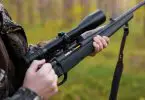
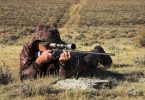

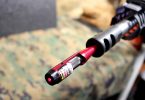

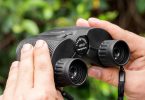

Leave a Comment